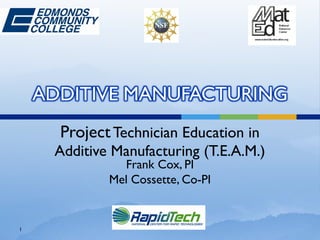Additive manufacturing
- 1. ProjectTechnician Education in Additive Manufacturing (T.E.A.M.) Frank Cox, PI Mel Cossette, Co-PI 1
- 2. ? Additive manufacturing (AM), noun ĻC process of joining materials to make objects from 3D model data, usually layer upon layer, as opposed to subtractive manufacturing methodologies. ? Synonyms: additive fabrication, additive processes, additive techniques, additive layer manufacturing, layer manufacturing and freeform fabrication. ? Rapid prototyping, noun ĻC additive manufacturing of a design, often iterative, for form, fit or functional testing or combination thereof. 2
- 3. ? As an Enabling Technology AM is used in a broad spectrum of manufacturing. ? Some applications of this technology include: 3
- 9. T.E.A.M. is a collaboration of two NSF funded Advanced Technological Education Centers and a Professional Organization ? The National Resource Center for Materials Technology Education; ? National Center for RapidTechnologies; and ? ASTM ? Develop Additive Manufacturing (AM) core competencies and curriculum, based on emerging Global AM Standards. 9
- 10. ? Goal 1: ? To facilitate creation of Additive Manufacturing core competencies and to develop uniform instructional elements and focused educational and training outcomes,T.E.A.M. will lend its knowledge and expertise to support F42 and its stakeholders in the development of Global Additive Manufacturing Standards. 10
- 11. ? Goal 2: ? To improve technician education training programs and to increase student career eligibility (employability/progression),T.E.A.M. will provide tools, expertise and a documented process model that integrates core competencies and relevant derivatives into manufacturing technician programs, aligned with the emergence of standards in real time. 11
- 12. ? How will this information be shared? ? Dissemination of the core competencies and curriculum through professional development opportunities, websites, conferences, professional organizations and appropriate publications. ? ASTM F42 Technical Committee ĻC over 120 members globally. 12
- 13. ? American Society for Testing and Materials International (ASTM) ? Is one of the largest voluntary standards developing organizations in the world. ? ASTMĄŊs strength is in developing and publishing standards based on a proven process. 13
- 14. ? Facilitate the development of full-consensus Global Standards for Additive Manufacturing Technologies through F42. ? Assist with publishing and disseminating a complete set of Additive Manufacturing Standards. ? Connect stakeholders input and review of competencies for validation. 14
- 15. ASTM T.E.A.M. F42 Technical Committee Sub-Committees Test Methods Design Materials & Processes Executive Terminology Education Working Group 15
- 16. F42 membership provides educational and technical input F42 Subcommittees Terminology Design Materials/ Processes Testing Executive Following ASTM consensus protocol, Standards developed and published T.E.A.M. develops Core Competencies Standards provide basis for Core Competency Development Core Competencies Published and disseminated T.E.A.M. Assists schools, colleges and industry with integration into curriculum/training Competencies used to develop instructional tools T.E.A.M. presents through websites, conferences, and professional development opportunities16
- 17. K = Knowledge S = Skill I = Importance (1=Vital, 2=Important, 3=Desirable, 4=unimportant) St = STEM category (S=Science, T=Technology, M=Math, E=Engineering) This material is based upon work supported by the National Science Foundation under Grant No. 1003530. Any opinions, findings, and conclusions or recommendations expressed in this material are those of the author(s) and do not necessarily reflect the views of the National Science Foundation. ASTM F2792 Standard Terminology for Additive Manufacturing Technologies 17
- 18. ? Continuing Education Programs. ? Industry Training Programs. ? Anyone developing an AM program ? Example:AM Certificate of Completion ? 3 quarters; 9 credits ? Edmonds Community College 18
- 19. Certificate of Completion in Additive Manufacturing? MST 161 Introduction to Additive Manufacturing 3 Credits ?Provides the student with knowledge and skills in Additive Manufacturing technology. Primary topics include additive manufacturing fundamentals, terminology, main categories of, and Rapid Prototyping machine technology types, advantages vs. disadvantages of varied Additive Manufacturing technologies, basic skills in 3-D software, and practical application of 3-D printing. ? MST 162 Additive Manufacturing, Molding and Casting 3 Credits ? Provides the student with knowledge and skills in Additive Manufacturing technology. Primary topics include vacuum forming fundamentals, silicon molding, urethane, investment casting, CNC operations and post processing of lab created projects. ? MST 163 Additive Manufacturing, Metal Printing 3 Credits ? Provides the student with knowledge and skills in Additive Manufacturing technology.The primary focus is using the advanced capabilities of 3D modeling software, the operation and theory of metal printing equipment, and the use of scanning equipment in the Additive Manufacturing industry. ? Prerequisites: Satisfactory completion of Engr. 114 (Introduction to Solid Works),or industry experience in CAD/CAM, or 1yr experience in the Additive Manufacturing industry, or instructor's permission. ? Total of 3 quarters/9 credits 19
- 20. ? Other Applications: Can you think of other areas where the use of AM technology would be appropriate? 20
- 21. ? Architecture and Design Morongo Casino, Palm Springs, Model21
- 22. ? Architecture and Design Morongo Casino, Palm Springs22
- 24. ? Automotive 24
- 25. ? Join ASTM F42 and work with a subcommittee to expedite development of AM standards. ? Learn about Additive Manufacturing. ? Participate in professional development opportunities offered in AM. ? Attend presentations like this. ? Visit Additive Manufacturing Websites. ( www.materialseducation.org) 25
- 26. For Additional Information Contact: Frank Cox PI ProjectT.E.A.M. Frank.cox@edcc.edu 425-640-1145 Mel Cossette Co-PI ProjectT.E.A.M. mel.cossette@edcc.edu 425-640-1376 This work is part of a larger project funded by the Advanced Technological Education Program of the National Science Foundation, DUE #1003530 26
Editor's Notes
- Possibly, keep in contact with MatEd @ EDCC for new information

























